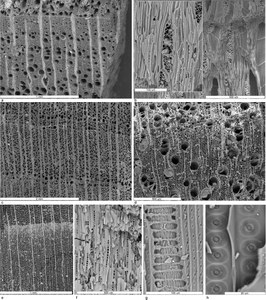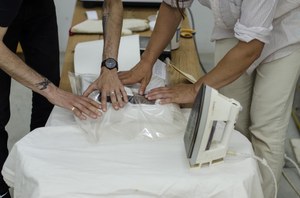Student Publications
Despite challenging circumstances over the past two years, ISAW graduate students have been publishing the results of their research on a variety of topics in peer-reviewed journals.
"A new anthracological sequence from Niğde-Kınık Höyük (Turkey): woodland vegetation and arboriculture in southern Cappadocia from the Late Bronze Age to the Ottoman Period"
Archaeological and Anthropological Sciences
Lorenzo Castellano
 SEM photos of wood charcoal of selected text. See article for more.
In this article, published in the journal Archaeological and Anthropological Sciences, I am presenting the results of the wood charcoal study conducted at the site of Niğde-Kınık Höyük, in southern Cappadocia, Turkey. This is part of a broader archaeobotanical project that I am conducting within the framework of my dissertation research, focused on the history of agriculture in pre-Roman Anatolia.
SEM photos of wood charcoal of selected text. See article for more.
In this article, published in the journal Archaeological and Anthropological Sciences, I am presenting the results of the wood charcoal study conducted at the site of Niğde-Kınık Höyük, in southern Cappadocia, Turkey. This is part of a broader archaeobotanical project that I am conducting within the framework of my dissertation research, focused on the history of agriculture in pre-Roman Anatolia.
Wood was a crucial resource in pre-modern societies, as it is well exemplified by its use in several everyday domestic and artisan activities. It is, thus, not surprising that charcoal fragments resulting from intentional or unintentional burning events are extremely abundant in archaeological deposits. If properly sampled and analyzed, this evidence represents an ‘archive’ of information, illuminating on the history of the local vegetation and its exploitation by human communities.
The study presented in this article is based on the analysis of more than 6700 wood charcoal fragments, extracted from 174 samples, dated from the Late Bronze Age to the Ottoman Period. In addition to provide information on the local vegetation history, the evidence from Niğde-Kınık Höyük allows to reconstruct the key importance of fruit-growing in southern Cappadocia, starting at least from the mid- 1 st millennium BCE. Viticulture appears to have played a pivotal role in this rich agricultural landscape, as documented by the abundant and ubiquitous attestation of grapevine charcoal. The central role of viticulture in southern Cappadocia is well supported by textual and iconographic evidence, spanning from the local Iron Age cult of the Storm God of the Vineyard to Ottoman tax records. The evidence from Niğde-Kınık Höyük provides the first direct archaeobotanical documentation of such importance and continuity in Central Anatolia.
"Fifty-plus years of on-site metals conservation at Sardis: Correlating treatment efficacy and implementing new approaches"
Peer-reviewed Preprints of the ICOM-CC 19th Triennial in Beijing 2021
Emily Frank
 Brian Castriota (co-author, L) and Emily Frank (R) sealing Escal enclosures for unstable metal objects at Sardis in 2019. (©Archaeological Exploration of Sardis/President and Fellows of Harvard College; Photo taken by E. Frank)
In the last sixty-one years, the Harvard-Cornell-led excavations at Sardis, Turkey, have produced over 5,000 copper-alloy and iron finds. Since their excavation, these finds have been stored in on-site depots, which provide only minimal buffer against seasonal fluctuations in relative humidity (RH). A condition survey conducted in 2016 and 2017 detected signs of chloride-related deterioration in roughly 40% of these finds. Conservation records since the 1960s document evolving stabilization treatment methods as new conservation research was put into practice. This paper describes a computa-tional approach informed by network analysis that was used to correlate the history of cop-per-alloy stabilization treatments at Sardis with deterioration phenomena encountered during our survey. Our newly implemented approach to rehousing unstable metals in low-RH and/or anoxic Escal enclosures is discussed along with our justification for maintaining certain treatment protocols in light of our findings and procedural shifts.
Brian Castriota (co-author, L) and Emily Frank (R) sealing Escal enclosures for unstable metal objects at Sardis in 2019. (©Archaeological Exploration of Sardis/President and Fellows of Harvard College; Photo taken by E. Frank)
In the last sixty-one years, the Harvard-Cornell-led excavations at Sardis, Turkey, have produced over 5,000 copper-alloy and iron finds. Since their excavation, these finds have been stored in on-site depots, which provide only minimal buffer against seasonal fluctuations in relative humidity (RH). A condition survey conducted in 2016 and 2017 detected signs of chloride-related deterioration in roughly 40% of these finds. Conservation records since the 1960s document evolving stabilization treatment methods as new conservation research was put into practice. This paper describes a computa-tional approach informed by network analysis that was used to correlate the history of cop-per-alloy stabilization treatments at Sardis with deterioration phenomena encountered during our survey. Our newly implemented approach to rehousing unstable metals in low-RH and/or anoxic Escal enclosures is discussed along with our justification for maintaining certain treatment protocols in light of our findings and procedural shifts.
"Price Laws and Items of Convenience: An Inquiry Into the Question of “Ancient Middle Class”"
Journal of Applied Business and Economics
Alireza Khounani
The main goal of this study is to make ancient economic data accessible to students and scholars of business and economics. It also demonstrates the capacity of classical and neoclassical economics for making theoretical contributions to economic history and anthropology. Primary data are drawn from Iraq and Iran between the sixth century BCE and the seventh century CE, with comparisons taken from the Mediterranean. Convenience is a useful concept for locating a middle class or an “intermediate economic group” in ancient societies. Symbolically, convenience may be understood through the notion of an “item of convenience,” which is necessary for creating an intermediate economic group. Convenience is also associated with comfort, which is only available to the elite and those intermediate economic groups who have access to limited surplus and are engaged in production, distribution, exchange, and consumption. Ancient price laws, which were intended to protect buyers and sellers, testify to institutional intervention among a group of people who were freely engaged in competitive market conduct and desired a more convenient access to fair market prices.